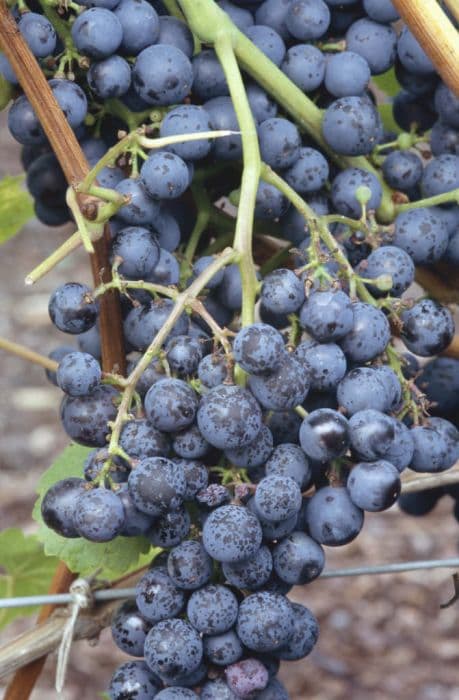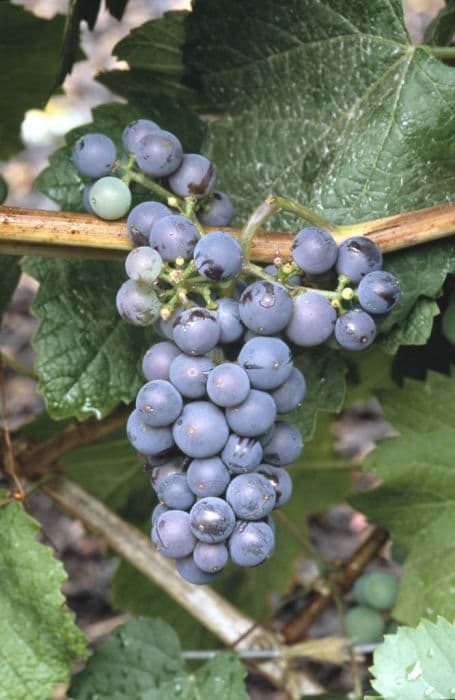Himalayan Ivy Parthenocissus himalayana var. rubrifolia

ABOUT
Commonly known as the Himalayan Virginia creeper, this climbing plant is known for its striking appearance. Its leaves are compounded with multiple leaflets, usually five, that emerge with a reddish hue before turning green as they mature. In the fall, the foliage undergoes a dramatic change, displaying vivid red and purple colors that add a spectacular decorative touch to any landscape where they're present. The Himalayan Virginia creeper also produces small inconspicuous flowers, which later give way to dark blue or black berries. The berries are not only a food source for birds but also contribute to the ornamental value of the plant with their contrast against the bright fall foliage. Its tendrils end in adhesive-like tips, allowing it to effectively cling to surfaces as it climbs. This creeping habit makes it an excellent plant for covering walls, fences, and other structures, which it can decorate with its lush, vibrant leaves. The plant's overall appearance with its attractive foliage color and climbing nature can transform any supporting structure into a living green wall with seasonal interest.
About this plant
 Names
NamesFamily
Vitaceae
Synonyms
Himalayan Virginia Creeper, Red-leafed Ivy
Common names
Parthenocissus himalayana var. rubrifolia.
 Toxicity
ToxicityTo humans
Himalayan Virginia creeper is not commonly listed as a toxic plant to humans. However, as with many plants, it's possible that some individuals might experience an allergic reaction or mild irritation when handling the plant or ingesting parts of it. There's no widespread evidence of severe poisoning or toxic symptoms associated with this plant, but it's always advisable to prevent ingestion of any plant material for which toxicity has not been definitively ruled out.
To pets
Information specifically regarding the toxicity of Himalayan Virginia creeper to pets is not extensively documented. While some members of the Parthenocissus genus can cause mild to moderate gastrointestinal symptoms in pets if ingested, such as vomiting or diarrhea, there is limited information on this particular variety. It is generally wise to prevent pets from ingesting plants that are not confirmed to be safe. If a pet does ingest this plant and shows any signs of distress, contacting a veterinarian would be the recommended course of action.
 Characteristics
CharacteristicsLife cycle
Perennials
Foliage type
Deciduous
Color of leaves
Varies
Height
30-40 feet (9-12 meters)
Spread
5-6 feet (1.5-1.8 meters)
Plant type
Climber
Hardiness zones
7
Native area
Himalayas
Benefits
 General Benefits
General Benefits- Ornamental Appeal: The Himalayan Woodbine adds aesthetic value to gardens and landscapes with its attractive reddish foliage and sprawling growth habit.
- Shade Provider: It can create shaded areas when grown over pergolas or arbors, offering a cool retreat during warmer months.
- Wall and Fence Cover: The plant is often used to cover unsightly walls or fences, providing a natural and appealing visual barrier.
- Erosion Control: Its root system can help stabilize soil and prevent erosion on slopes or in areas prone to soil loss.
- Wildlife Habitat: It offers shelter and sometimes food to a variety of birds and small wildlife within its dense foliage.
 Medical Properties
Medical PropertiesThis plant is not used for medical purposes.
 Air-purifying Qualities
Air-purifying QualitiesThis plant is not specifically known for air purifying qualities.
 Other Uses
Other Uses- Façade greening: Himalayan Virginia creeper is often used to cover walls and façades of buildings, providing a natural, aesthetic appeal and helping to regulate building temperatures.
- Privacy screening: The dense foliage of the plant can create a living privacy screen on balconies, patios, or in gardens.
- Noise reduction: When used as a green wall, the plant can absorb sound, thereby reducing noise pollution in urban environments.
- Seasonal interest: The plant adds visual interest to gardens with its seasonal color changes, showcasing vibrant red leaves in the fall.
- Wildlife support: It offers habitat and food for birds and insects, including nesting sites and berries as a food source.
- Erosion control: The plant's extensive root system helps stabilize slopes and prevent soil erosion.
- Corporate branding: Businesses use Himalayan Virginia creeper to create living logos or green branding elements on their premises.
- Shade provision: The lush canopy formed by the mature plant can provide cooling shade in outdoor seating areas or over patios.
- Cultural practices: In some cultures, the vine may be used in traditional ceremonies or decorations, particularly because of its vibrant autumn colors.
- Photography subject: The stunning foliage of Himalayan Virginia creeper makes it a popular subject for nature and garden photographers.
Interesting Facts
 Feng Shui
Feng ShuiThe plant Himalayan Virginia Creeper is not used in Feng Shui practice.
 Zodiac Sign Compitability
Zodiac Sign CompitabilityThe plant Himalayan Virginia Creeper is not used in astrology practice.
 Plant Symbolism
Plant Symbolism- Growth and Vitality - The vigorous nature of the Himalayan Virginia Creeper, as it spreads across structures and trees, symbolizes robust growth and the dynamic energy of life.
- Attachment and Support - Similar to how the plant uses tendrils to attach to surfaces for support, it can represent interdependence and the importance of relationships for mutual growth and stability.
- Transformation - The plant's foliage undergoes a stunning color transformation from green to vivid reds in the autumn, representing the idea of transformation and change as positive and natural parts of life.
- Adaptability - Able to thrive in various conditions, the Himalayan Virginia Creeper suggests the theme of adaptability and resilience in the face of different environments and challenges.
 Water
WaterThe Himalayan Virginia Creeper should be watered deeply once a week, providing about 1 to 1.5 gallons of water for each plant to ensure the soil is thoroughly moistened. During hot and dry periods, increase watering to twice a week. It's important to avoid overwatering, so ensure the soil has good drainage and check the soil moisture before adding more water. Cut back on watering in the fall and winter when the plant is dormant. Always water at the base of the plant to minimize the risk of leaf diseases.
 Light
LightThe Himalayan Virginia Creeper thrives in full sun to partial shade. The ideal location is one where the plant receives at least 4-6 hours of direct sunlight each day, but it can also tolerate some shade, especially during the hottest part of the day. Avoid deep shade as it can lead to poor growth and less vibrant colors.
 Temperature
TemperatureThe Himalayan Virginia Creeper prefers temperatures between 60°F and 80°F, but it can survive in temperatures as low as 20°F and as high as 90°F. To ensure robust growth, try to avoid exposure to extreme temperatures outside of this range, especially sustained periods of frost or intense heat.
 Pruning
PruningPruning the Himalayan Virginia Creeper is essential to control its growth and maintain a desired shape. Prune in late winter or early spring before new growth starts. Cut back any unwanted or overgrown vines and remove dead or damaged growth. Periodic trimming throughout the growing season may be necessary to keep the plant in bounds.
 Cleaning
CleaningAs needed
 Soil
SoilThe Himalayan Virginia Creeper prefers a well-draining, loamy soil mix with a pH between 5.5 and 7.5. A mixture of garden soil, compost, and peat or coco coir can create an ideal environment for its growth.
 Repotting
RepottingThe Himalayan Virginia Creeper should be repotted every 2 to 3 years, or when it becomes root-bound and the growth seems to slow down.
 Humidity & Misting
Humidity & MistingThe Himalayan Virginia Creeper thrives in moderate humidity levels ranging from 40% to 70%, but it is quite adaptable and can tolerate the lower humidity levels typically found in homes.
 Suitable locations
Suitable locationsIndoor
Place in bright, indirect light and let soil slightly dry between watering.
Outdoor
Choose a sunny or semi-shaded spot; water regularly, but don't overwater.
Hardiness zone
7-9 USDA
 Life cycle
Life cycleParthenocissus himalayana var. rubrifolia, more commonly known as the Himalayan Virginia Creeper, begins its life cycle as a seed, which germinates in spring under suitable moisture and temperature conditions. Once germinated, it enters a growth phase, developing a strong root system and vine-like shoots that cling to surfaces with tendrils as it seeks sunlight. The plant then matures and undergoes vigorous vegetative growth, with leaves that turn from green to red in the fall. During the reproductive stage, the creeper produces small, inconspicuous flowers in the summer, which are followed by blue-black berries that are distributed by birds, enabling propagation. After seeding, the plant enters a period of dormancy during the colder winter months, conserving energy to resume its growth cycle the following spring. Over years, this perennial plant will expand considerably and can cover large areas, demonstrating its aggressive and invasive growth habit.
 Propogation
PropogationPropogation time
Spring-early summer
Propogation: The most common method for propagating the Himalayan Virginia creeper (Parthenocissus himalayana var. rubrifolia) is through stem cuttings. During spring to early summer, when the plant is actively growing, take cuttings measuring about 4 to 6 inches (10 to 15 centimeters) long from healthy, mature vines. The cut should be made just below a node, as this is where the roots will sprout. Remove the leaves from the lower half of the cutting to avoid excess moisture loss, and optionally dip the cut end into a rooting hormone to encourage root development. Plant the cutting in a well-draining potting mix, ensuring that at least one node is buried where roots can develop. Keep the medium moist and place the cutting in a warm, indirect light environment until roots have established, typically within a few weeks, after which it can be transplanted into the garden or a larger pot.
![Grape [Claret Cloak]](/_next/image?url=https%3A%2F%2Fplants-admin.emdemapps.com%2Fimages%2Fplants%2F%2Fimages%2F604b602abe2f8.png&w=640&q=75)








